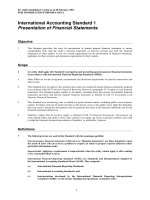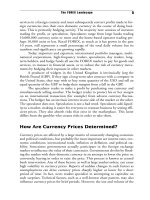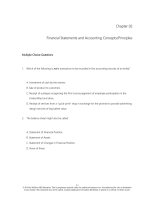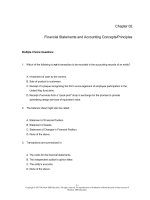Lecture Accounting: What the numbers mean (5/e) - Chapter 7: Accounting for and presentation of liabilities
Bạn đang xem bản rút gọn của tài liệu. Xem và tải ngay bản đầy đủ của tài liệu tại đây (154.86 KB, 36 trang )
CHAPTER 7
ACCOUNTING FOR AND
PRESENTATION OF
LIABILITIES
McGrawHill/Irwin
©The McGrawHill Companies, Inc., 2002
Learning Objectives
1.
2.
3.
What is the financial statement
presentation of short-term debt and
current maturities of long-term debt?
What is the difference between
interest calculated on a straight basis
and on a discount basis?
What are unearned revenues and
how are they presented in the
balance sheet?
McGrawHill/Irwin
©The McGrawHill Companies, Inc., 2002
Learning Objectives
4.
5.
6.
7.
What is the accounting for
employer’s liability for payroll and
payroll taxes?
What is the importance of making
estimates for certain accrued
liabilities and how are these items
presented in the balance sheet?
What is leverage and how is it
provided by long-term debt?
What are the different
characteristics of a bond?
McGrawHill/Irwin
©The McGrawHill Companies, Inc., 2002
Learning Objectives
8.
9.
10.
Why does bond discount or premium
arise and how is it accounted for?
What are deferred income taxes and
why do they arise?
What is minority interest, why does it
arise, and what does it mean in the
balance sheet?
McGrawHill/Irwin
©The McGrawHill Companies, Inc., 2002
Learning Objective 1
•
What is the financial statement
presentation of short-term debt
and current maturities of longterm debt?
McGrawHill/Irwin
©The McGrawHill Companies, Inc., 2002
Current Liabilities
•
Amounts due within one year or
operating cycle
•
A working capital loan is a short-term
loan with the expectation that it will be
repaid from the collection of accounts
receivable generated by the sale of
inventory
•
A revolving line of credit is a
predetermined maximum amount, but
flexibility in timing and amount
borrowed
McGrawHill/Irwin
©The McGrawHill Companies, Inc., 2002
Notes Payable
•
A note is a formal promise to pay a
stated amount at a stated date, usually
with interest
•
Prime rate is the term frequently used to
express the interest rate on short-term
loans
McGrawHill/Irwin
©The McGrawHill Companies, Inc., 2002
Learning Objective 2
•
What is the difference between
interest calculated on a straight
basis and on a discount basis?
McGrawHill/Irwin
©The McGrawHill Companies, Inc., 2002
Interest Calculation Methods
•
Straight interest is calculated as follows:
Interest = Principal X Rate X Time (in years)
•
A discount is interest that is subtracted from
the loan principal and the borrower receives
the difference
•
The difference received by the borrower is
called the proceeds
•
The discounted amount is shown in the
balance sheet as a contra liability
McGrawHill/Irwin
©The McGrawHill Companies, Inc., 2002
Current Maturities of LongTerm Debt
•
The portion of long-term borrowing
that must be repaid within a year of
the balance sheet date is reported as
a current liability
•
The remainder of the long-term debt
is shown in noncurrent liabilities
McGrawHill/Irwin
©The McGrawHill Companies, Inc., 2002
Accounts Payable
•
Accounts payable are amounts owed to
suppliers for goods and services that have
been provided to the entity on credit
•
May be reported using either the gross or
the net method
•
The gross method recognizes cash
discounts when the invoices are paid within
the discount period
•
The net method recognizes cash discounts
when purchases are made
McGrawHill/Irwin
©The McGrawHill Companies, Inc., 2002
Learning Objective 3
•
What are unearned revenues
and how are they presented in
the balance sheet?
McGrawHill/Irwin
©The McGrawHill Companies, Inc., 2002
Unearned Revenues or
Deferred Credits
•
Unearned revenues occur when customers
pay for goods or services before the goods or
services are delivered:
Cash
•
XX
Unearned revenue
XX
When earned, the liability of unearned
revenues is removed and recorded as
revenues:
Unearned revenue
Revenue
McGrawHill/Irwin
XX
XX
©The McGrawHill Companies, Inc., 2002
Learning Objective 4
•
What is the accounting for employer’s
liability for payroll and payroll taxes?
McGrawHill/Irwin
©The McGrawHill Companies, Inc., 2002
Payroll Taxes and
Other Withholdings
•
Gross pay is wages earned by
an employee
•
Net pay is the amount the employee
receives after deductions
•
Deductions include federal income tax,
state income tax, FICA withholding,
union dues, and many others
McGrawHill/Irwin
©The McGrawHill Companies, Inc., 2002
Liabilities from Withholdings
•
Amounts withheld are liabilities to the
employer until paid
•
Additional liabilities result since
employers are subject to federal and
state payroll taxes
•
These payroll taxes are an expense to
the employer
McGrawHill/Irwin
©The McGrawHill Companies, Inc., 2002
Other Accrued Liabilities
•
There are many other liabilities that
are accrued by entities
–
Accrued property taxes
–
Estimated warranty liabilities
–
Accrued interest – if not reported
separately
McGrawHill/Irwin
©The McGrawHill Companies, Inc., 2002
Learning Objective 5
•
What is the importance of making
estimates for certain accrued
liabilities and how are these
items presented in the balance
sheet?
McGrawHill/Irwin
©The McGrawHill Companies, Inc., 2002
Presentation of
Accrued Liabilities
•
Estimates of accrued liabilities are
presented on the balance sheet as current
liabilities since they are due within one year
of the balance sheet date
•
These estimated items are originally
recorded as increases in expenses and
increases in liabilities
•
Adjustments are made to the liabilities as
the actual cost is determined
McGrawHill/Irwin
©The McGrawHill Companies, Inc., 2002
Learning Objective 6
•
What is leverage and how is it
provided by long-term debt?
McGrawHill/Irwin
©The McGrawHill Companies, Inc., 2002
Noncurrent Liabilities
•
Capital structure is the mix of debt and
owners’ equity used to finance the
acquisition of the firm’s assets
•
Using long-term debt has the
advantage of having interest expense
being deductible – whereas dividends
on stock are not deductible
McGrawHill/Irwin
©The McGrawHill Companies, Inc., 2002
Financial Leverage
•
Financial leverage is the difference
between the rate of return earned on
assets (ROI) and the rate of return
earned on owners’ equity (ROE)
•
A firm can borrow money to purchase
assets and use those assets to earn a
rate of return greater than the interest
incurred on the borrowed funds
McGrawHill/Irwin
©The McGrawHill Companies, Inc., 2002
Learning Objective 7
•
What are the different characteristics
of a bond?
McGrawHill/Irwin
©The McGrawHill Companies, Inc., 2002
Bonds Payable
•
Most long-term debt is issued in the
form of bonds
•
A bond is a formal debt document
usually issued in denominations of
$1,000
•
Bond prices are expressed as a
percentage of the bonds principal
amount
McGrawHill/Irwin
©The McGrawHill Companies, Inc., 2002
Learning Objective 8
•
Why does bond discount or
premium arise and how is it
accounted for?
McGrawHill/Irwin
©The McGrawHill Companies, Inc., 2002









